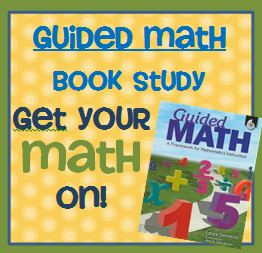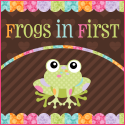
Brenda at Primary Inspired hosted chapter one of this fabulous book study. Dana at 3rd Grade Gridiron is hosting chapter 2.
As I look over the Foundational Principles of Guided Math I feel like there are a couple of areas that I could make some improvements in my classroom.
The first is in the area of “a numeracy-rich environment”.
I fear my classroom falls into the category of “literacy rich, with some signs of mathematic instruction being evident”. I have math manipulatives, math books, a calendar board…but what I want to create in my classroom is what Laney Sammons describes as “mathematically rich classroom environment”.
Here are a few of the goals I believe will help me create this kind of environment:
Math Journals: Last year I got my students more involved in our calendar time, by having them fill out a calendar page each day as we went through our calendar board. My students were much more engaged and I felt like my calendar time was more beneficial. This year I would like to incorporate the use of a math journal. Based on the information from this chapter, I think I will include a section for vocabulary, calendar, problem solving, and resource section that would include graphic organizers and charts to help students organize their thinking.
Anchor Charts: Miller (2002) “Anchor charts make our thinking permanent and visible , and so allow us to make connections from one strategy to another, clarify a point, build on earlier learning, and simply remember a specific lesson”. When I walk into my classroom, everywhere I look I see anchor charts for reading and writing. My students know that literacy is important in our classroom. I want it to be the same feeling for math. I am going to work hard to make our math learning more visible by using anchor charts and a math word wall. I think it is important that these charts have to “be created in the classroom with student participation”.
The second area I want to focus on during this next year is “building and maintaining a mathematical learning community”.
Expectations: I agree so strongly with the statement of page 38 of this book, “When a teacher has high expectations for all students, struggling students tend to live up to expectations and other students’ perceptions of them reflect those expectations.” I know that when we work together as a community of learners, we become more confident in our ability to organize our thinking, talk about our thinking, listen and learn from our peers, and use appropriate math vocabulary to discuss our ideas.
Math Books by Student Authors: I have always made class and individual books relating to our study of literacy. I have not however, done a great job of encouraging my students to write math-related books. I am excited to have my students write about math ideas. What a great way to bring our study of math into our writing workshop.
I would really love to hear your ideas of incorporating a math journal and student authored math books into your classroom.





















































I agree with you on what Laney Sammons described as “mathematically rich classroom environment”. I feel like I do a good job of making sure I have a literacy rich environment but have very few numeracy related charts other than the calendar math wall. I also liked the idea of having students make math related books.
ReplyDeleteRose
"The Wonderful World of Kindergarten"
I think sharing student-authored math books would be such a great way to help my students learn math vocabulary.
DeleteI feel like I need to make more anchor charts for math also! All of my anchor charts seem reading & writing related & I want to balance it out. Thanks for sharing your thoughts on this book! I am following along with the book study. :)
ReplyDeleteLisa
Learning Is Something to Treasure
It's amazing how many more reading & writing charts I have! I was thinking that I should put copies of my anchor charts in their math journals as well. That way they would have them to refer to all year.
DeleteI loved doing a problem of the day with my calendar journal and I think you will too. My little ones really got good at them by March. I completely agree with you I need to create more charts about math and create more class books incorporating math in them as well.
ReplyDeleteThanks for sharing your thoughts.
Sue
The Very Busy Kindergarten
I am excited to incorporate math journals more effectively next year. I would love to see the kinds of questions you used.
DeleteGreat post! I'm in the same boat as all of you--tons of literacy, little bit of math. I did sort of incorporate a math journal this year, though. We called it a thinkpad because it was a notebook that they used to record thoughts about math, problems, notes, drawings, etc...I feel like I could do even more next year, though. Instead of making math books, I'd like to have my students make videos or some sort of technology project explaining the math concepts they learn.
ReplyDeleteThinkShareTeach
Ooh! I love your idea of making videos about math! I can see my kiddos getting very excited about that, & what a great.way to tie in technology!
DeletePrimary Inspired
Wow! I love the video idea as well!! I can see this being a valuable assessment tool! I would also like to use it to show parents.
DeleteI have used math journals for years and I LOVE them. I also have clipboards for each child with a blank 100 chart, calendar, and other things to fill out, I started this several years ago so that the kiddos followed along and shared responsibility for their learning.
ReplyDeleteThanks for this post, I really enjoyed this and am going to get this book. I can't wait to read the next chapter post.
Thanks again,
Jill
Bubbalulu.blogspot.com
I'm curious about what you include in your math journals? Do you use a 3-ring binder or something else??
DeleteI'd love to see your calendar page! Is that something you could post?
ReplyDeletePrimary Inspired
Brenda,
DeleteWhat a great book choice!! Thanks so much for hosting this awesome online book-study! It is so wonderful to share ideas with so many amazing teachers. I tried a couple of different ideas with calendar pages this year, and I am in the process of tweaking what I did. One thing I want to try this year is to add different elements of my calendar more gradually. I think it was a little overwhelming to my new firsties last year. I would be happy to post it as soon as I'm finished.
Thanks for linking up!!!
ReplyDeleteDana
I really enjoyed your thoughts on chapter two. Thank you for stopping by!!
DeleteLast year our class read Emily's First 100 Days of School by Rosemary Wells. Each day of school we read that "day" page in the book. After a couple of days my students decided it would be fun to create our own class 100 Days of School book. n the beginning it was a shared writing experience. At a certain point it became a permanent math station. It was so fun and incorporated math!
ReplyDeleteBrittany
Sweet Seconds
I love this idea
DeleteBarrow's Hodgepodge
Love this idea Brittany! Thanks for sharing it...I am headed to Amazon right now to buy the book!!
ReplyDeleteLove the thought of Math Anchor Charts. I'll finally be in a normal size classroom next year - so looking forward to "stretching" out towards a numeracy-enriched classroom.
ReplyDelete